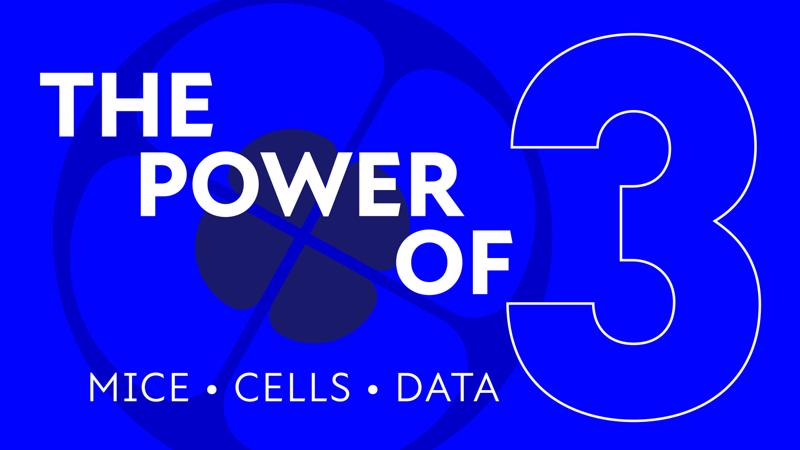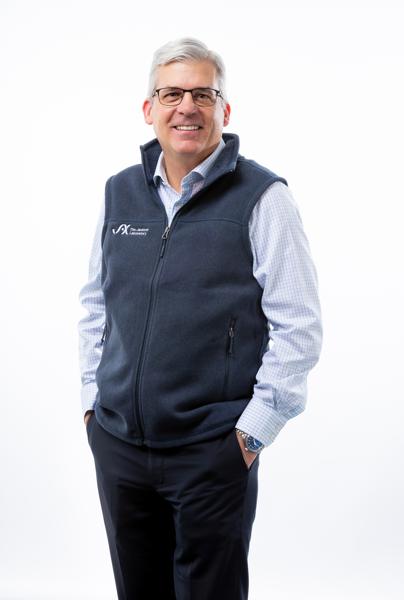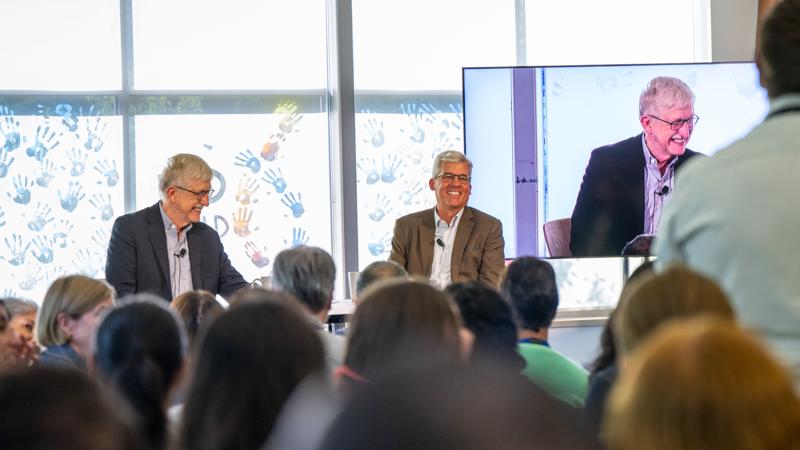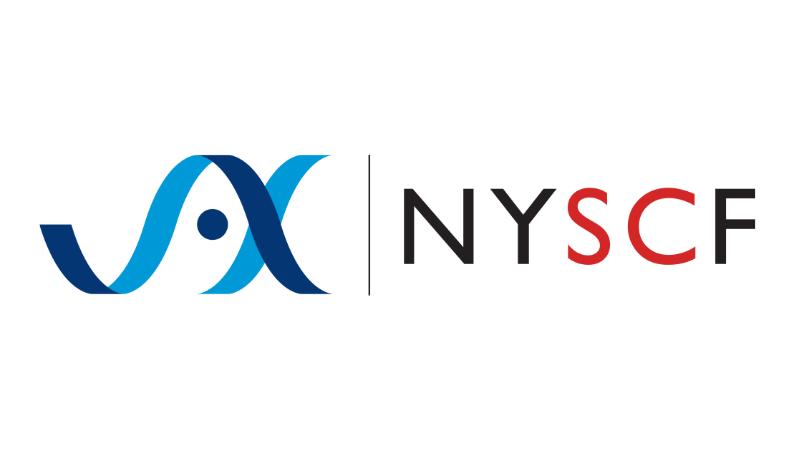The power of 3: Building an integrated discovery platform
Article | October 20, 2025

In his own words, JAX President and CEO Lon Cardon reflects on his vision for the JAX‑NYSCF Collaborative, and how this powerful partnership brings together people, ideas and innovation to accelerate discoveries and improve human health.
British statistician George Box famously said: “All models are wrong, but some are useful.” Models simplify reality. They’re not perfect; their true value lies in helping us understand complex systems, like biology, and translate that understanding into actionable insights that can improve human health.
At JAX, “models” refer to our more than 14,000 unique mouse strains, each engineered to mimic human diseases, like cancer, Alzheimer’s, rare genetic disorders and more. JAX® Mice are the gold standard in biomedical research. More than 2,400 organizations around the world rely on these models to power some of the most significant discoveries of our time.
However, even the best model is only as good as the question it’s built to answer. When a model doesn’t deliver what we expect, it’s not always a failure of the model. Instead, it may be a sign that we’re using a model that is poorly suited to address our intended question. Good models challenge assumptions. Mice don’t lie. They reveal. And, sometimes, they tell us truths to questions we weren’t asking.
A shifting biomedical landscape
Animal models, for all their strengths and contributions, are under scrutiny. In 2022, the FDA Modernization Act 2.0 was signed into law. Animal testing is no longer required for drug approval. As I write this, the National Institutes of Health (NIH) announced it will no longer fund animal-only studies. While researchers can still secure funding for animal studies if alternatives are considered, these changes reflect a shifting biomedical landscape, and JAX has been preparing for it for years.
At JAX, we have long championed the principles of the 3Rs of animal research (replacement, reduction and refinement) as part of our culture, nonprofit mission and focus on advancing science responsibly. Our researchers are embracing advanced technologies including AI analysis, human cellular models, organoids and organs‑on‑chips to explore complex biology. These tools offer exciting opportunities to accelerate the pace of biological discovery.
The simple fact is that mice are not humans — and human cells and AI, for all their promise, lack the systemic complexity of a whole organism for validation. These approaches are not replacements for animal models. They are complements to each other. And when used together they can offer unprecedented insights.
The future isn’t about choosing one model over another, it’s about integrating them.
AI helps scientists generate hypotheses and refine them faster than ever before. Cell‑based models allow us to rapidly screen those ideas in a human-derived context. Mouse models validate them in a complex organism. Together, they form a discovery platform that is far greater than the sum of its parts.
A legacy in cellular modeling
JAX has long been a pioneer in cellular modeling. In 1958, JAX scientist Leroy Stevens laid the very foundation for today’s stem cell research and positioned JAX at the forefront of this innovation with his groundbreaking work on strain 129 mice. He even coined the phrase “pluripotent stem cells,” referring to cells that are capable of developing into any type of tissue.
Fast forward to today — we continue to lead. A number of JAX scientists including Martin Pera and Bill Skarnes have advanced this field for decades, keeping JAX at the forefront of cellular modeling research.
Despite this progress, when it comes to distributing cell lines with the same rigor and reliability as our mouse models, the field is in its relative infancy. It’s the Wild West.
Unlike our mouse models, where standardization is the norm, most cell models today are inconsistent. Cells mutate. Researchers receive lines that differ from those they ordered previously. This lack of reproducibility slows progress and undermines trust. Science requires reproducibility.
Some say JAX’s greatest innovation was the laboratory mouse, and this is certainly an enviable legacy, but I believe the mouse is the outcome of something even more impactful: our commitment to standardization, characterization and quality. When a scientist orders a mouse from JAX, they receive the same model they would have received a decade ago, no matter where they are in the world. That consistency is what makes research using JAX models more reliable, more reproducible and, ultimately, more impactful. That’s exactly what the world needs for cells.
And we’re poised to deliver.
From mouse to models
Let me be clear: JAX is not abandoning the mouse. Far from it. AI and cell models will increasingly drive early-stage discovery. As that stage accelerates, the most promising targets will surface faster and they’ll need to be validated in the most predictive, human‑like models available. That’s JAX’s strength.
Expanding into cellular modeling is more than a strategic move, it’s a transformational one that will be a key part of JAX’s legacy for the next 100 years. We have the commercial engine, scientific expertise, and soon, the scalability to produce and distribute cell models with the same reliability and excellence as our mice.
That is why I am so thrilled to be joining forces with NYSCF. A world leader in stem cell science, their groundbreaking NYSCF Global Stem Cell Array® sets them apart. NYSCF’s research in Alzheimer’s, Parkinson’s, diabetes, cancer and more complement our research priorities.

This summer in Bar Harbor, we hosted physician and scientist Francis Collins, who served for 12 years as Director of the NIH. He said of the alliance: “I’m thrilled about this coming together of two remarkable institutions. If you’re going to take on really tough problems in biomedicine, you want to have the full menu of approaches — and now we do. We’ve got the animals, the cells, the organoids, the stem cells, and the expertise. I don’t know of any other place that’s brought all that together into such a cohesive network. There’s no place better than JAX to make that happen. I could not be more excited about what’s ahead.”
I couldn’t agree more. Make no mistake: this is not an incremental step. It’s a bold move, one that reaffirms our mission and redefines our future.
Defining what is ‘useful’
At the beginning of this piece, I shared George Box’s famous words. His quote resonates with me because it doesn’t question the value of models, it reinforces what makes them powerful.
Their strength isn’t in perfection; it’s in enabling us to ask better questions.
That’s exactly what we’re doing at JAX. We’re building a discovery platform for the future, one that embraces the complementary strengths of AI, cells and mouse models. It’s not about choosing one model over another. It’s about the power of their essential integration.
Thanks to JAX’s unmatched strength in one of those three components, the mouse, we’re uniquely poised to bring these tools together. To borrow from Box’s words, it’s about usefulness. The best models don’t just give us answers, they help us see what’s possible to improve human health. That’s the kind of science we’re committed to and the future we’re building together.
Learn more

Introducing a new era of biomedical discovery
The Jackson Laboratory’s acquisition of the New York Stem Cell Foundation unites complementary strengths across mouse, cell, and computational models — creating an unmatched platform to accelerate discovery and transform human health.
View more
Scope. Speed. Scale.
The bold new alliance between The Jackson Laboratory (JAX) and The New York Stem Cell Foundation (NYSCF) promises to transform biomedical research and bring life-changing therapies to patients faster than ever before.
View more